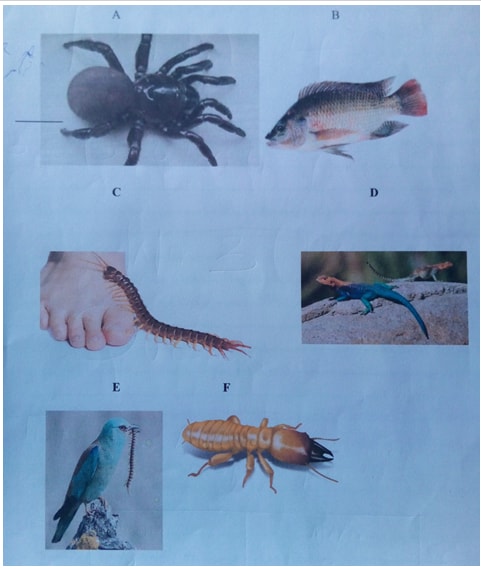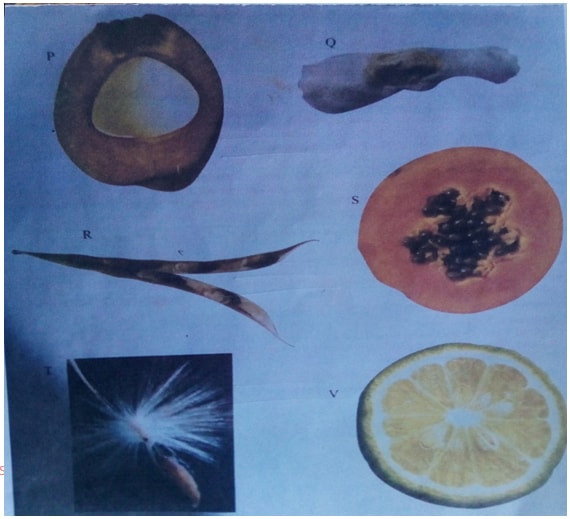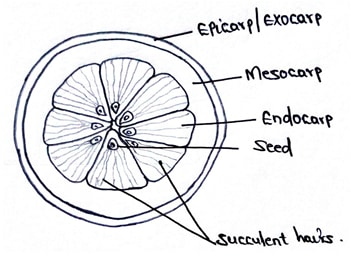BIOLOGY PAPER 3 - KAPSABET BOYS 2019 TRIAL MOCK EXAMINATION
Get the complete BIOLOGY PAPER 3 - KAPSABET BOYS 2019 TRIAL MOCK EXAMINATION PDF on WhatsApp by tapping on the button
- Study the organisms below

- Complete and use the key below to identify the organisms (2mks)
1a) Organism with endoskeleton …………………………………………………………...go to 2
1b) __________...........................................................................go to 4
2a) Has scales on the body ………………………………………………………………..…..go to 4
2b) Has no scales on the body …………………………………………………………….…mammalian
3a) Has cephalothorax …………………………………………………………………………...Arachnida
3b) Has no cephalothorax …………………………………………………………….………..go to 5
4a) ___________________________.............................................Pisces
4b) Has no fins …………………………………………………………………………………………go to 7
5a) Has three pairs of legs ………………………………………………………………………..Insect
5b) Has more than three pairs of legs ……………………………………………………….go to 6
6a) Two pairs of legs per segment …………………………………………………………..Diplopoda
6b) One pair of legs per segment …………………………………………………………….Chilopoda
7a) Has feathers ………………………………………………………………………………………… Aves
7b) Has no feathers …………………………………………………………………………………go to 8
8a) Has a tail ……………………………………………………………………………………………Reptilia
8b) Has no tail …………………………………………………………………………………………Amphibia - Identify the organisms above using the completed key above (6mks)
Specimen Steps followed Identity
A ___________________ ______________________
B ___________________ ______________________
C __________________ ______________________
D __________________ ______________________
E __________________ _____________________
F _________________ ______________________ - Name the phylum in which specimens C, E and F belong to. (1mk)
- Give three reasons for your answer in (c) above (3mks)
- Name one feature that is common in organisms B, E and D (1mk)
- Complete and use the key below to identify the organisms (2mks)
- You are provided with the following;
- Hydrogen peroxide
- Specimen K
- Pestle and mortar
- 4 test tubes
- A scalpel
- Source of heat
- Test tube holder
Using a scalpel, obtain three peeled cubed from specimen K measuring about 1cm x 1cm x 1cm. For the first cube, you are required to boil it in water for five minutes. For the second cube, you are required to crush it into a paste. For the last cube, you are required to use it as it is.
Label three test tubes A, B and C and put 2ml of hydrogen peroxide in each test tube. To test tube A, add the boiled cube and record your observation.
To test tube B. add the crushed paste and record your observation.
To test tube C, add the unboiled cube remaining and record your observation.- Complete the table below (3mks)
Test tube
Observation
A
B
C
- Explain your observation in test tube A (1mk)
- Between test tubes B and C, in which test tube was the volume of foam produced the highest? Explain (3mks)
- Apart from temperature, state two other factors that affect the rate of enzyme controlled reactions (2mks)
- Complete the table below (3mks)
- The photographs below shows specimen of different types of fruits. Examine them and answer the questions that follow.

- State four differences between specimen P and R (4mks)
- State the types of gynoecium and placentation of specimen P, S and V (4mks)
- Specimen P Gynoecium
Placentation - Specimen S Gynoecium
Placentation - Specimen V Gynoecium
Placentation
- Specimen P Gynoecium
- In the table below name the mode of dispersal for each specimen and the features that adapt the specimen to its mode of dispersal. (6mks)
Specimen
Mode of dispersal
Adaptive features
P
Q
R
S
T
v
- Draw and label a plan diagram of specimen V (4mks)
MARKING SCHEME
-
- 1b- Organism with exoskeleton
4a – Has fins -
Specimen
Steps followed
Identity
A
B
C
D
E
F
1a, 3a
1a, 2a, 4a
1b, 3b, 5b, 6b
1a, 2a, 4b, 7b, 8a
1a, 2a, 4b, 7a
1b, 3b, 5a
Arachnida
Pisces
Chilopoda
Reptilia
Aves
Insecta
- Arthropoda reject Antropoda or arthropoda.
- – They all have an exoskeleton
- They all have segmented bodies
- They all have jointed appendages/limb - Scales;
- 1b- Organism with exoskeleton
-
-
Test tube
Observation
A
No effervescence/no bubble production /No foam production
B
High effervescence rate/high rate of bubble formation
C
Little effervescence/ bubble formation/little foam formation.
Reject no reaction - No effervescence /bubble formation/form formation because boiling denatured the enzymes (catalase enzyme) hence hydrogen peroxides, was not broken down into water, and oxygen gas.
- Test tube B, because crushing of the cube increased the surface area for proper enzyme (catalase) action hence a high volume of hydrogen peroxide was broken down into water and oxygen compared to the cube in test tube c which has a small surface area expose to the hydrogen peroxide solution.
- PH, enzymes and substrate concentration contraction, enzyme inhibitors, co-enzymes and co-factors.
-
-
- - P has one seed while R has many seeds
- P has a thick pericarp while R has thin
- P has distinct epicarp, mesocarp and endo carp while R have the three layer’s indistinct suture lines.
- P has a hollow seed while the seeds of are not hollow. - - Specimen P – Gynoecium is monocarpous placentation basal.
- Specimen S – Gynoecium is syncarpous spacentation parietal
- Specimen V – Gynoecium is syncarpous placentation is axile/central -
Specimen
Mode of dispersal
Adaptive features
P
Water
Hairy mesocarp /air spaces for buoyancy
Q
Wind
Wing-like membranous structure/extensions
R
Self by explosive mechanism
Has lines of weakness/sutures
S
Animals
Fleshy /succulent
T
Wind
Has hair-like projections/parachute of hairs
V
Animals
Fleshy /succulent
- A plan diagram of specimen V

- - P has one seed while R has many seeds